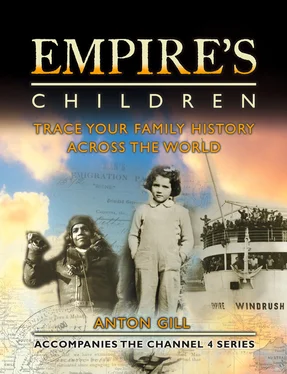Chillingly, the slaves were referred to as ‘product’, in rather the same way as the Nazis later referred to the Jews. Rebellious slaves (and there were several rebellions) suffered vicious punishments, and those who stole sugar cane to eat themselves could, if caught, look forward to being flogged, to having their teeth pulled out, and to other cruel humiliations, as one Jamaican estate owner noted in his diary in May 1756, having caught two slaves ‘eating canes’: ‘Had [one] well flogged and pickled, then made [the other] shit in his mouth.’ Slaves who escaped headed for the hills where they formed their own communities, governed by a system of laws developed by themselves. The British, borrowing a word from the Spanish cimarrones (peak-dwellers), called them ‘Maroons’. So successful and independent did these communities become that the British, despairing of destroying them, eventually concluded treaties with them, and, ironically, engaged them to hunt down other escaped slaves.
THE SLAVE TRADE CONSTITUTED ONE OF THE GREATEST MIGRATIONS IN RECORDED HISTORY.
In the course of the eighteenth century, when the slave trade peaked, more than 1,650,000 people were uprooted, shipped and sold. The slave trade constituted one of the greatest migrations in recorded history. In England itself, and especially in London, there was a sizeable black population – Simon Schama tells us that there were between 5,000 and 7,000 in mid-eighteenth-century London alone. All of them were technically free, while resident in Britain, under the law, but many, despite the intervention of early activists such as Granville Sharp on their behalf, were cruelly abused by their employers. Some, like Dr Johnson’s servant, Francis Barber, enjoyed the benefits of education and became minor celebrities. Others, especially young men and boys, were often employed in aristocratic houses as pages – the modern equivalent of fashion accessories, dressed in exotic costumes believed suitable to their backgrounds. Yet others eked out a precarious living as musicians or waiters. There were a few soldiers and sailors. For women, the choice was stark: most only had recourse to either begging or prostitution.
ABUSE OF COLONIZED PEOPLES AND OF FORMER SLAVES CONTINUED EVEN LONGER. IN SOME PLACES, IT CONTINUES TODAY.
By the end of the eighteenth century, an abolition movement gathered momentum in Britain. A medallion was struck by the pottery magnate Josiah Wedgwood in the 1790s showing a kneeling, chained slave, and bearing the legend ‘Am I not a man and a brother?’, which did much to popularize the cause; and its supporters succeeded in bringing about an end to the slave trade and then slavery itself by Acts of Parliament passed in 1807 and 1833. The institution itself did not die out instantly. It lingered long in India, and in the former British colonies in America it would survive for another thirty years at least. And abuse of colonized peoples and of former slaves continued even longer. In some places, it continues today. The descendants of slaves, of course, form the majority of the populations of the Caribbean states today.
England was not only expanding in the western hemisphere. Coffee – its name derives from the Arabic qahwah – spread to Europe from the Muslim world (its origins in antiquity are in Ethiopia), and towards the end of the seventeenth century it became an immensely chic, and expensive, drink in London, where coffee houses blossomed almost as fast as chains like Starbucks do today. Tea – even pricier – followed, imported from China. Chocolate, much drunk in the eighteenth century, quickly followed. These new and popular tastes for the exotic suggested new markets. The Dutch had established trading links with the Spice Islands of south-west Asia at the beginning of the seventeenth century, and colonized them under the aegis of the Dutch East India Company. Queen Elizabeth I granted a charter to the Royal East India Company in 1600, according it the usual high-handed carte blanche, irrespective of any other nation. Rivalry between the Dutch and the English concerns simmered throughout the 1600s, leading to a string of Anglo-Dutch wars towards the end of the century, but resolved by the accession of William of Orange to the British throne in 1689. The French East India Company established a base at Pondicherry (now Puducherry) in 1673, creating further rivalry as the trading possibilities opened up in India began to promise rich rewards.
The English established trading stations in Surat, in what was to become Madras (now Chennai) and in what was to become Calcutta. In 1661 Charles II of England received Bombay (now Mumbai) as part of the dowry due on his marriage to the Portuguese Catherine of Braganza. The Portuguese had colonized the Goan coastal strip over one hundred years earlier. ‘Bombay’ derives from the Portuguese bom baia – ‘good bay’. Much of the rest of India at the time was under the control of the fading Mughal empire (one of the last great emperors, Shah Jahan, created the Taj Mahal as a tomb for his wife in the middle of the seventeenth century), but the subcontinent was also divided into petty kingdoms whose warlike rivalries worked to the advantage of the European interlopers.
Trade dominated here initially, not colonization, and far from encountering unsophisticated tribes who could easily be dominated, the local peoples here were organized and powerful. Initially, the Europeans stuck to their coastal trading stations and bickered among themselves. The sea voyage east had to be made via the Cape of Good Hope (where Britain also established coastal bases) and was considerably longer (six months) than that to the Americas (about eight weeks), so East India Company officials enjoyed a great degree of latitude and independence, often making private fortunes on their own account.
The process by which India gradually fell under exclusively British control is long and complex, but, briefly, the Dutch were outmanoeuvred because they had a less versatile range of goods to trade with. The French, whose main centre was at Pondicherry, just south of Madras, ultimately foundered when the ambitious governor of the Compagnie des Indes, the Marquis Dupleix, fell foul of one of the first great heroes of the British Empire, Robert Clive. Clive, a severely flawed and pugnacious character who was to commit suicide (succeeding at the third attempt) at the age of forty-nine in 1774, was nevertheless a brilliant soldier and an able and astute administrator and negotiator. When the equally truculent Dupleix, with the aid of Indian allies, took Madras (then called Fort St George) in 1746, Clive recaptured it, and went on to take Pondicherry from the French, effectively neutralizing their influence. Not long after this campaign (1751–3), Clive, after a brief interval in England, returned to India to crush another enemy.
In 1756 the Nawab of Bengal, Siraj Ud Daulah, became disaffected with the East India Company’s interference in the internal affairs of his country, and sensed (correctly) a threat to his independence. In June 1756, he ordered an immediate stop to improvements in the fortifications of Fort William in Calcutta. The Company ignored him. Thereupon the Nawab laid siege to the fort and took it after a bloody battle. His troops imprisoned about 120 British and Indian survivors – men, women and children – in a barrack which measured only about 4.5 by 5.5 metres, and left them there without food or water overnight. The air to breathe was limited among such a large number, the heat was atrocious, and when the prisoners were released the next morning it was found that only twenty-three were still alive. This was the famous Black Hole of Calcutta.
Apart from the need to nip this rebellion in the bud, for the British were indeed planning to use Bengal as a base for greater expansion in India, the affront demanded vengeance. Clive acted swiftly, moving north from Madras, and took Calcutta with relative ease on 2 January 1757. Siraj continued his fight, but the British forces had superior discipline and weaponry, and he was defeated finally at the Battle of Plassey towards the end of June. Titular control of Bengal passed to Siraj’s former commander-in-chief, who was already in Clive’s pocket. The hegemony of the East India Company was assured, and, incidentally, once Bengal was surely in its grasp, the Company took over the lucrative opium trade, formerly the preserve of the Dutch, and exported the drug to China.
Читать дальше












